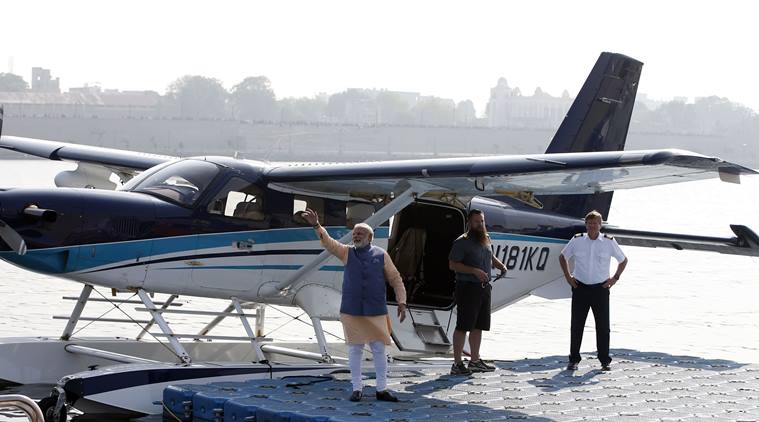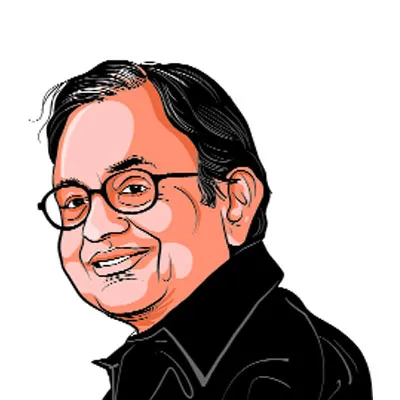Opinion Across the aisle: Now, return to governance
The new normal is that every rule will be bent to influence the election.
 The prime minister in 2017 boarded a seaplane in Gujarat as part of efforts to promote water-based tourism activities and waterways. (Express Photo: Javed Raja)
The prime minister in 2017 boarded a seaplane in Gujarat as part of efforts to promote water-based tourism activities and waterways. (Express Photo: Javed Raja)  On the last day of camping for the Gujarat Assembly elections, Prime Minister Narendra Modi boards a seaplane from Sabaramati riverfront, Ahmadabad to visit Ambaji temple. Express Photo by Javed Raja
On the last day of camping for the Gujarat Assembly elections, Prime Minister Narendra Modi boards a seaplane from Sabaramati riverfront, Ahmadabad to visit Ambaji temple. Express Photo by Javed Raja
Come to the world of the new normal. The new normal is that elections will be fought not on the performance of the ruling party (of 22 years, in the case of Gujarat) but on an indiscreet remark that will be distorted and blown out of proportion to the weight it deserved.
The New Normal
The new normal is that outrageous allegations can and will be levelled against a former Vice-President of India, a former Prime Minister of India, a former Chief of Army Staff, former High Commissioners to Pakistan and several former civil servants and, when called out, an apology will be demanded from the former Prime Minister!
The new normal is that the government’s position will become the ‘national’ position and every one will be forbidden to hold a view contrary to the ‘national’ position! (So, believe that demonetisation was good, the design and implementation of the GST were perfectly fine, the ‘first-ever surgical strike’ pulverised Pakistan and the Doklam standoff ended in a decisive victory for India over China).
The new normal is that every rule will be bent to influence the election — ride on a borrowed seaplane from the Sabarmati waterfront to the Dharoi dam on the last day of campaign or launch a new submarine on polling day.
In the run-up to the parliamentary election in 2014, Mr Narendra Modi had re-invented himself as a moderate politician whose paramount interest was the economic development of India and, in fact, of all the people of India. Many controversial aspects of his brand of governance as Chief Minister of Gujarat were buried in a brilliantly conceived and imaginatively executed election campaign. The result vindicated the person and the campaign.
That model was turned on its head in the election to the Gujarat Legislature. In a state that the BJP had ruled for 22 years, the party did not run on its record. The BJP’s campaign was a textbook case study of how a well-oiled election machine, bereft of ethics and using unlimited resources, can blur the difference between truth and hype. The party may still ride to victory.
Heed the Warning Signals
Meanwhile, the economy continues to tank. The fact that the government is celebrating a minor upturn in the growth rate (from 5.7 per cent in Q1 of 2017-18 to 6.3 per cent in Q2) is quite telling. In October 2017, the Index of Industrial Production grew by a paltry 2.2 per cent over the same month a year ago. Manufacturing grew by 2.5 per cent. Inflation continued to rise: retail inflation that was 3.6 per cent in October inched up to 4.9 per cent in November and it was driven by the rise in prices of essential items of consumption. For example, inflation in vegetable prices was 22.5 per cent, up from 7.5 per cent in the previous month. Agriculture recorded a dismal growth rate of 1.7 per cent in the second quarter (July-September) of 2017-18.
The numbers are not likely to get much better in the near term. In July-September 2017, only 246 private sector projects with a total expected investment of Rs 43,492 crore were announced. It was the lowest in more than 10 years. Corporate India has neither the appetite nor the money to make new investments. In Q1 and Q2 of the current year, corporate profits shrunk by 21 per cent and 8.6 per cent, respectively, over the corresponding quarters of 2016-17.
I do not know when the government will engage with the real — and worrisome — issues concerning the economy. On December 14, the Prime Minister made an important speech at the annual meeting of FICCI. The headline-grabbing point was that there was an organised loot of the banking system by the previous government! As expected, the lambs in the gathering were silent and some even cheered!
Truth vs Hype about NPAs
Is the NPA problem a case of organised loot? The facts speak for themselves (see table):

At the end of March 2014, Rs 2,16,739 crore of loans were non-performing. That means that the remaining loans were performing and interest and instalments of the principal were being paid regularly. Why did the performing loans become non-performing? Why did the NPAs of private sector banks also increase nearly fourfold from Rs 19,986 crore to Rs 73,842 crore? The answer is the downturn in the domestic economy and the deterioration in the external environment that affected exports. Of course, there was also malfeasance by some borrowers.
Besides, there is another question that the government has shied away from answering. How much of the NPA amount at the end of March 2017 were loans given after the NDA took office in May 2014? Further, if the charge of organised loot is correct, why did the banks (and the government) write off, in the period 2014-15 to 2016-17, a sum of Rs 1,88,287 crore of the loans to defaulters?
I hope that after the unedifying spectacle of the election campaign in Gujarat, we can return to a debate on the economy, but the debate cannot start on a false note and an unsubstantiated charge. As candidate Bill Clinton said, “It’s the economy, stupid”, and the economy is still in the sick ward.





